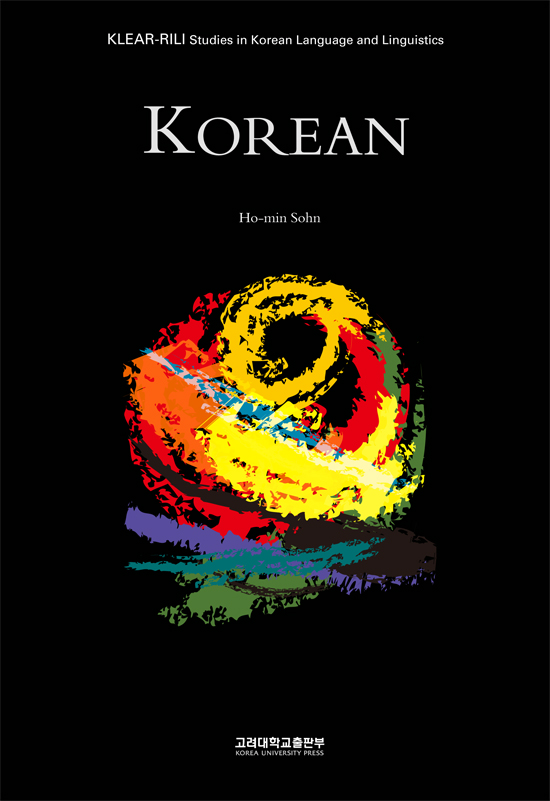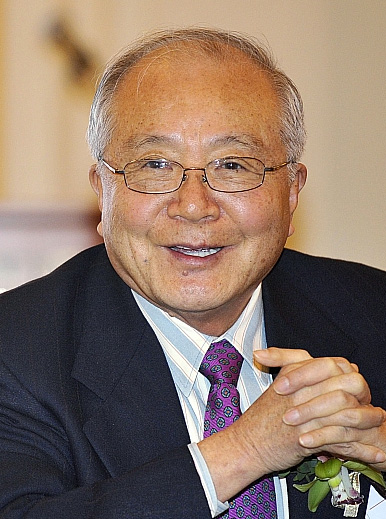세계적인 언어학자 Bernard Comrie가 기획한 총서(전세계 언어들 중에서 한국어를 포함하여 각 유형별, 어족별 대표성을 띠는 Abkhaz, Kobon, Mangarayi, Tamil, WestGreenlandic, Japanese, Rumanian, Modern Greek, Amele, Basque, Gulf Arabic, kannada, Finnish, Catalan, Punjabi, Maori 등의 주요 언어들을 선정하여 철저하게 기술적인 입장에서 해당 언어의 문법을 설명하는 것을 목표로 했다)의 한 권으로 출간되어 한국어 전공자나 한국어 교육자뿐만 아니라 일반 언어학자들에게도 한국어의 기술문법적 이해와 설명을 위한 필독서로 자리잡은 책이다. 1994년 Routledge 출판사에서 간행된 후 품절된 책을 다시 편집하여 2013년판으로 펴냈다.
“한국어 교사와 학생, 학자들을 위한 친절한 문법서이다. 한국어 구조에 관하여 이론중립적인 태도로 광활하면서도 섬세한 서술을 해내고 있는 이 책은 포괄적인 참고서로서 이론적 지향점과 무관하게 모든 한국어 학자에게 유용하며, 그런 한편 초급 수준 이상으로 한국어를 공부하는 학생들이라면 얼마든지 접근 가능한 책이기도 하다.” — Yumiko Kawanishi(University of California, Los Angeles)의 서평
PREFACE to the KUP Edition
PREFACE
TABLE OF ROMANIZATION SYSTEMS
ABBREVIATIONS
INTRODUCTION
CHAPTER 1. SYNTAX
1.1. General properties
1.1.1. Sentence types
1.1.1.1. Direct speech and quoted speech
1.1.1.2. Interrogative sentences
1.1.1.3. Imperative sentences
1.1.1.4. Propositives and other sentence types
1.1.1.5. Indirect speech acts
1.1.2. Subordination
1.1.2.1. Markers of subordination
1.1.2.2. Noun clauses
1.1.2.3. Adjectival (relative) clauses
1.1.2.4. Adverbial clauses
1.1.2.5. Sequence of tenses
1.2. Structural properties
1.2.1. Internal structure of the sentence
1.2.1.1. Copular sentences
1.2.1.2. Verb sentences
1.2.1.3. Adverbials
1.2.2. Adjective phrases
1.2.2.1. Operational definition of adjective phrase
1.2.2.2. Arguments of adjectives
1.2.2.3. Adjective-modifying adverbs
1.2.2.4. Order of constituents
1.2.3. Adverbial phrases
1.2.3.1. Operational definition of adverbial phrase
1.2.3.2. Elements modifying adverbials
1.2.3.3. Relative order
1.2.3.4. Restrictions
1.2.4. Postpositional phrases
1.2.4.1. Operational definition for postpositional phrase
1.2.4.2. Postpositional phrases and their arguments
1.2.4.3. Modification of postpositions
1.2.4.4. Multiple case governing of postpositions
1.2.5. Noun phrases (nominal constituents)
1.2.5.1. Operational definition for noun phrase
1.2.5.2. Modifiers in noun phrases
1.2.5.3. Multiple modification and order of constituents
1.3. Coordination
1.3.1. Sentential coordination
1.3.2. Coordination of words and phrases
1.3.3. Number of coordinators
1.3.4. Coordination and comitative
1.3.5. Cooccurrence between different types of elements
1.3.6. Omission under identity
1.4. Negation
1.4.1. Sentence negation
1.4.2. Constituent negation
1.4.3. Multiple negation
1.4.4. Negation in coordinated structure
1.4.5. Negation by predicate in higher clause
1.5. Anaphora
1.5.1. Means of expressing anaphora
1.5.2. Syntactic properties of anaphoric expression
1.6. Reflexives
1.6.1. Means of reflexivity expression
1.6.2. Scope of reflexivity
1.6.3. Intraclause reflexivity
1.6.4. Positional possibilities within clause
1.6.5. Antecedent and reflexive
1.6.6. Reflexive relations within nominalized clauses
1.6.7. Reflexive relations within noun phrases
1.6.8. Reflexives without overt antecedent
1.6.9. Other uses of reflexives
1.7. Reciprocals
1.7.1. Means to express reciprocals
1.7.2. Scope of reciprocality
1.7.3. Antecedent and reciprocal
1.8. Comparison
1.8.1. Means to express comparison
1.8.2. Omitted elements
1.8.3. Correlative comparison
1.9. Equatives
1.9.1. Means to express equatives
1.9.2. Omitted elements
1.10. Possession
1.10.1. Constructions of possessive sentences
1.10.2. Alienable versus inalienable possession
1.10.3. Temporary versus permanent possession
1.10.4. Possession of persons, animals, and things
1.10.5. Present versus past possession
1.11. Emphasis
1.11.1. Sentence emphasis
1.11.2. Constituent emphasis
1.11.3. Focus of yes-no questions
1.12. Topic
1.12.1. Means to indicate topic of a sentence
1.12.2. Elements to be topicalized
1.12.3. Trace in movement
1.12.4. Topicalization as obligatory or optional
1.13. Heavy shift
1.13.1. General
1.13.2. Structures subject to heavy shift
1.13.3. Positions for heavy shift
1.14. Other movement processes
1.14.1. Scrambling
1.14.2. Postposing
1.15. Minor sentence-types
1.15.1. Lack of main predicate
1.15.2. Omission of main clauses
1.16. Word-classes
1.16.1. Categorization of word-classes
1.16.2. Noun
1.16.3. Pronoun
1.16.4. Verb
1.16.5. Adjective
1.16.6. Adverb
1.16.7. Determiner
1.16.8. Particle
1.16.9. Word-class summary
CHAPTER 2. MORPHOLOGY
2.1. Inflection
2.1.1. Noun inflection
2.1.1.1. Indicators of noun phrase functions
2.1.1.2. Expression of syntactic functions
2.1.1.3. Syntactic functions with nonfinite verbs
2.1.1.4. Nonlocal semantic functions
2.1.1.5. Local semantic functions
2.1.1.6. Location in time
2.1.1.7. Double case-marking
2.1.1.8. Nominal number-marking
2.1.1.9. Noun classes
2.1.1.10. Definiteness in noun phrases
2.1.1.11. Indefiniteness in noun phrases
2.1.1.12. Referentiality in indefiniteness
2.1.1.13. Genericness in noun phrases
2.1.1.14. Relative importance of noun actors
2.1.2. Pronouns
2.1.2.1. Personal pronouns
2.1.2.2. Reflexive pronouns
2.1.2.3. Reciprocal pronouns
2.1.2.4. Possessive pronouns
2.1.2.5. Demonstrative pronouns
2.1.2.6. Interrogative pronouns and other question words
2.1.2.7. Relative pronouns and other relative words
2.1.3. Verb morphology
2.1.3.1. Voice
2.1.3.2. Tense
2.1.3.3. Aspect
2.1.3.4. Mood
2.1.3.5. Nonfinite forms
2.1.3.6. Other inflectional categories
2.1.3.7. Strings of verbs
2.1.4. Adjectives
2.1.4.1. Predicative versus attributive
2.1.4.2. Absolute versus contingent
2.1.4.3. Agreement
2.1.4.4. Comparison
2.1.4.5. Degrees of quality
2.1.4.6. Predicative inflectional categories
2.1.5. Postpositions
2.1.6. Numerals and quantifiers
2.1.6.1. Numeral forms in counting
2.1.6.2. Cardinal numerals as attributes
2.1.6.3. Distinct numerals for different objects
2.1.6.4. Ordinal numerals
2.1.6.5. Other derivatives of numerals
2.1.6.6. Quantifiers
2.1.7. Adverbs
2.1.7.1. Expressions of comparison
2.1.7.2. Degrees of quality
2.2. Derivational morphology
2.2.1. Nominal derivation
2.2.1.1. Nouns from nouns
2.2.1.2. Nouns from verbs
2.2.1.3. Nouns from adjectives
2.2.1.4. Nouns from adverbs
2.2.1.5. Nouns from determiners
2.2.2. Verb derivation
2.2.2.1. Verbs from nouns
2.2.2.2. Verbs from verbs
2.2.2.3. Verbs from adjectives
2.2.2.4. Verbs from adverbs
2.2.3. Adjective derivation
2.2.3.1. Adjectives from nouns
2.2.3.2. Adjectives from verbs
2.2.3.3. Adjectives from adjectives
2.2.3.4. Adjectives from adverbs
2.2.4. Adverb derivation
2.2.4.1. Adverbs from nouns
2.2.4.2. Adverbs from verbs
2.2.4.3. Adverbs from adjectives
2.2.4.4. Adverbs from adverbs
2.2.4.5. Adverbs from determiners
2.2.5. Determiner derivation
2.2.6. Postpositional derivation
2.2.6.1. Postpositional compounds
2.2.6.2. Complex postpositions
2.2.6.3. Derived postpositions
2.2.7. Compound morphology
2.2.7.1. General properties of Korean compounds
2.2.7.2. Compound nouns
2.2.7.3. Compound verbs
2.2.7.4. Compound adjectives
2.2.7.5. Compound adverbs
2.2.7.6. Compound determiners
CHAPTER 3. PHONOLOGY
3.1. Phonological units (segmental)
3.1.1. Distinctive segments
3.1.2. Phonetic characteristics
3.2. Phonotactics
3.2.1. Admissible simple consonants
3.2.2. Admissible consonant clusters
3.2.3. Admissible vowels
3.2.4. Structure of lexical morphemes
3.2.5. Syllable structure
3.2.6. Cooccurrence restrictions
3.3. Suprasegmentals
3.3.1. Distinctive length
3.3.2. Stress
3.3.3. Pitch
3.3.4. Intonation
3.4. Morphophonology (segmental)
3.4.1. Sound alternations
3.4.2. Metathesis processes
3.4.3. Coalescence processes
3.4.4. Deletion and insertion
3.4.5. Reduplication
3.4.6. Consonant weakening in irregular verbs
3.5. Morphophonology (suprasegmental)
3.5.1. Vowel shortening
3.5.2. Stress, tone, and intonation
CHAPTER 4. IDEOPHONES AND INTERJECTIONS
4.1. Ideophones
4.1.1. Sound symbolism
4.1.2. Structural aspects
4.1.3. Sample list
4.2. Interjections
4.2.1. Interjectional types
4.2.2. Structural features
4.2.3. Sample list
CHAPTER 5. LEXICON
5.1. General characteristics of Korean lexicon
5.2. Structured semantic fields
5.2.1. Kinship terminology
5.2.2. Color terminology
5.2.3. Body parts
5.2.4. Cooking terminology
5.3. Basic vocabulary
BIBLIOGRAPHY
INDEX
저자 : 손호민Ho-min Sohn
HO-MIN SOHN is Professor of Korean linguistics and Director of the Korean Language Flagship Center at the University of Hawaii at Manoa (UHM) and President of the Korean Language Education and Research Center, Inc. which has developed twenty Korean language textbooks. He is a past chair of the Department of East Asian Languages and Literatures (1993-2000) and a past director of the Center for Kor... more





